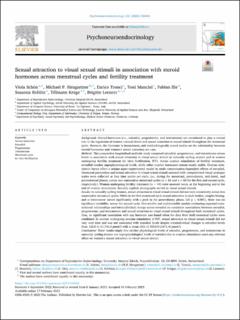Please use this identifier to cite or link to this item:
https://doi.org/10.21256/zhaw-27243| Publication type: | Article in scientific journal |
| Type of review: | Peer review (publication) |
| Title: | Sexual attraction to visual sexual stimuli in association with steroid hormones across menstrual cycles and fertility treatment |
| Authors: | Schön, Viola Hengartner, Michael P. Tronci, Enrico Mancini, Toni Ille, Fabian Röblitz, Susanna Krüge, Tillmann Leeners, Brigitte |
| et. al: | No |
| DOI: | 10.1016/j.psyneuen.2023.106060 10.21256/zhaw-27243 |
| Published in: | Psychoneuroendocrinology |
| Volume(Issue): | 151 |
| Issue: | 106060 |
| Issue Date: | 2023 |
| Publisher / Ed. Institution: | Elsevier |
| ISSN: | 0306-4530 1873-3360 |
| Language: | English |
| Subjects: | Sexual attraction; Estradiol; Progesterone; Testosterone; Menstrual cycle; In vitro fertilization |
| Subject (DDC): | 610: Medicine and health |
| Abstract: | Background: Steroid hormones (i.e., estradiol, progesterone, and testosterone) are considered to play a crucial role in the regulation of women’s sexual desire and sexual attraction to sexual stimuli throughout the menstrual cycle. However, the literature is inconsistent, and methodologically sound studies on the relationship between steroid hormones and women’s sexual attraction are rare. Methods: This prospective longitudinal multisite study examined estradiol, progesterone, and testosterone serum levels in association with sexual attraction to visual sexual stimuli in naturally cycling women and in women undergoing fertility treatment (in vitro fertilization, IVF). Across ovarian stimulation of fertility treatment, estradiol reaches supraphysiological levels, while other ovarian hormones remain nearly stable. Ovarian stimulation hence offers a unique quasi-experimental model to study concentration-dependent effects of estradiol. Hormonal parameters and sexual attraction to visual sexual stimuli assessed with computerized visual analogue scales were collected at four time points per cycle, i.e., during the menstrual, preovulatory, mid-luteal, and premenstrual phases, across two consecutive menstrual cycles (n = 88 and n = 68 for the first and second cycle, respectively). Women undergoing fertility treatment (n = 44) were assessed twice, at the beginning and at the end of ovarian stimulation. Sexually explicit photographs served as visual sexual stimuli. Results: In naturally cycling women, sexual attraction to visual sexual stimuli did not vary consistently across two consecutive menstrual cycles. While in the first menstrual cycle sexual attraction to male bodies, couples kissing, and at intercourse varied significantly with a peak in the preovulatory phase, (all p ≤ 0.001), there was no significant variability across the second cycle. Univariable and multivariable models evaluating repeated cross-sectional relationships and intraindividual change scores revealed no consistent associations between estradiol, progesterone, and testosterone and sexual attraction to visual sexual stimuli throughout both menstrual cycles. Also, no significant association with any hormone was found when the data from both menstrual cycles were combined. In women undergoing ovarian stimulation of IVF, sexual attraction to visual sexual stimuli did not vary over time and was not associated with estradiol levels despite intraindividual changes in estradiol levels from 122.0 to 11,746.0 pmol/l with a mean (SD) of 3553.9 (2472.4) pmol/l. Conclusions: These results imply that neither physiological levels of estradiol, progesterone, and testosterone in naturally cycling women nor supraphysiological levels of estradiol due to ovarian stimulation exert any relevant effect on women’s sexual attraction to visual sexual stimuli. |
| URI: | https://digitalcollection.zhaw.ch/handle/11475/27243 |
| Fulltext version: | Published version |
| License (according to publishing contract): | CC BY 4.0: Attribution 4.0 International |
| Departement: | Applied Psychology |
| Organisational Unit: | Psychological Institute (PI) |
| Published as part of the ZHAW project: | Psychoneuroendokrinologie |
| Appears in collections: | Publikationen Angewandte Psychologie |
Files in This Item:
| File | Description | Size | Format | |
|---|---|---|---|---|
| 2023_Schoen-etal_Sexual-attraction-to-visual-stimuli-across-menstrual-cycles-fertility-treatment.pdf | 922.21 kB | Adobe PDF |  View/Open |
Show full item record
Schön, V., Hengartner, M. P., Tronci, E., Mancini, T., Ille, F., Röblitz, S., Krüge, T., & Leeners, B. (2023). Sexual attraction to visual sexual stimuli in association with steroid hormones across menstrual cycles and fertility treatment. Psychoneuroendocrinology, 151(106060). https://doi.org/10.1016/j.psyneuen.2023.106060
Schön, V. et al. (2023) ‘Sexual attraction to visual sexual stimuli in association with steroid hormones across menstrual cycles and fertility treatment’, Psychoneuroendocrinology, 151(106060). Available at: https://doi.org/10.1016/j.psyneuen.2023.106060.
V. Schön et al., “Sexual attraction to visual sexual stimuli in association with steroid hormones across menstrual cycles and fertility treatment,” Psychoneuroendocrinology, vol. 151, no. 106060, 2023, doi: 10.1016/j.psyneuen.2023.106060.
SCHÖN, Viola, Michael P. HENGARTNER, Enrico TRONCI, Toni MANCINI, Fabian ILLE, Susanna RÖBLITZ, Tillmann KRÜGE und Brigitte LEENERS, 2023. Sexual attraction to visual sexual stimuli in association with steroid hormones across menstrual cycles and fertility treatment. Psychoneuroendocrinology. 2023. Bd. 151, Nr. 106060. DOI 10.1016/j.psyneuen.2023.106060
Schön, Viola, Michael P. Hengartner, Enrico Tronci, Toni Mancini, Fabian Ille, Susanna Röblitz, Tillmann Krüge, and Brigitte Leeners. 2023. “Sexual Attraction to Visual Sexual Stimuli in Association with Steroid Hormones across Menstrual Cycles and Fertility Treatment.” Psychoneuroendocrinology 151 (106060). https://doi.org/10.1016/j.psyneuen.2023.106060.
Schön, Viola, et al. “Sexual Attraction to Visual Sexual Stimuli in Association with Steroid Hormones across Menstrual Cycles and Fertility Treatment.” Psychoneuroendocrinology, vol. 151, no. 106060, 2023, https://doi.org/10.1016/j.psyneuen.2023.106060.
Items in DSpace are protected by copyright, with all rights reserved, unless otherwise indicated.